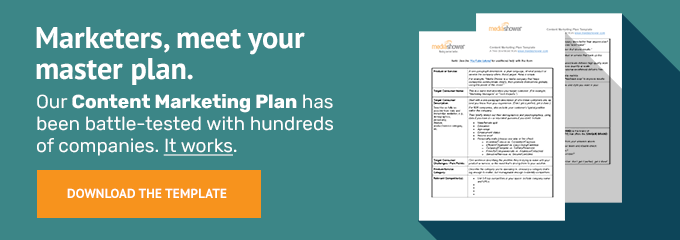The Marketing Brief: Blueprints, Examples, and Templates
TL;DR: Why and how should you have a marketing brief? We break it down here, including how to write a marketing brief, its purpose, and must-have components. Also, our AI Marketing Brief Generator will create a pretty good marketing brief for you in just a few minutes.
So What? For companies that are working on their marketing (and who isn’t?), a well-written marketing brief can get everyone aligned.
Why does your marketing campaign need a marketing brief? Because the brief is your plan of attack. It comprises all your outreach work, meaning a smoother rollout, better team collaboration, and a greater return on investment.
How to Use Our Marketing Brief Generator
Just answer a few questions about your marketing campaign, your business or product, and your target audience, and our AI Marketing Brief Generator will draft a marketing brief for you.
Remember: the more information you give it, the better your marketing brief will get. You can keep refining the brief until you’re happy with the results — then have it emailed to you, instantly and free.
What’s a Marketing Brief?
A marketing brief is a short written document that provides a comprehensive overview of a specific marketing project, campaign, or initiative.
It serves as a guide for all your stakeholders, ensuring that everyone is aligned on the objectives, strategies, and deliverables. With a good marketing brief, your campaign can run smoothly from concept to completion.
A marketing brief is essential because it:
- Provides clarity and direction for the marketing team, and any external partners or agencies.
- Ensures alignment among all stakeholders.
- Acts as a reference point throughout the campaign, helping to keep the project on track.
What’s the difference between a marketing brief and a marketing plan?
- A marketing plan is a larger document that tackles the marketing team’s strategies, tactics, and resources to achieve its desired marketing goals.
- A marketing brief is a shorter document (hence the name), typically focused on a specific campaign. But the brief should always align with the plan. Easier said than done!
A 2021 survey by BetterBriefs shows that 80% of marketers believe they have a handle on writing briefs–but only 10% of agencies agree with that self-assessment. This same survey shows that 95% of marketers have failed to provide strategic direction to their agencies, with one-third of budgets lost to poor briefs that provide no direction.
This is a wake-up call for marketers. Marketing briefs are critical for marketing success – but only when done well.
Marketer’s Takeaway: Your brand needs a marketing plan and brief for every campaign. These help ensure you meet your goals, target the right audience(s), and convey the most persuasive messages. Don’t believe it? See compelling data here and here.
What to Include in a Marketing Brief
A well-written marketing brief – which often lays the foundation of a larger content marketing plan – will give everyone a complete picture of why you’re launching the marketing campaign and what you intend to gain from them.
Here are the key components typically found in a marketing brief (though yours may vary)::
- Background/Introduction: This section provides context about your company, product, or service. It might include a brief history, current market position, and any relevant past marketing efforts.
- Objectives: Clearly defined goals that your marketing initiative aims to achieve. These could be related to brand awareness, sales targets, lead generation, etc.
- Target Audience: A description of the primary and secondary audiences the campaign is targeting. This might include demographics, psychographics, and any other relevant details about the target consumers.
- Key Messages: The main points or messages that the campaign should convey to the target audience.
- Budget: An outline of the available budget for the campaign.
- Timeline: A schedule or timeline for the campaign, including key milestones and deadlines.
- Deliverables: A list of expected outputs from the campaign, such as advertisements, content pieces, events, etc.
- Tone and Branding Guidelines: Direction on the voice, style, and branding elements to be used in the campaign.
- Measurement and KPIs (Key Performance Indicators): Metrics that will be used to evaluate the success of the campaign.
- Supporting Materials: This could include market research, customer insights, previous campaign results, or any other relevant data.
Marketer’s Takeaway: Your marketing brief may look different from the above, but it should touch on all these basic points. Visit Smart Insights for a deeper dive into marketing brief components, and Rocket Content for excellent tools to gauge a campaign’s success.
Why You Need Research

The secret ingredient that turns a good brief into a great one? Research.
Research is important for a few reasons:
- Understanding Your Target Audience: Research can help you understand the needs, preferences, and pain points of your target customer.
- Identifying Market Trends: Research helps you ensure your campaigns are relevant and timely.
- Analyzing Competitors: Research helps you understand what competitors are doing right (or wrong), and better differentiate your campaign.
- Setting Realistic Objectives: Research provides data. And data-driven objectives are not only clear and specific, but also measurable. You can set realistic goals, and track them.
- Optimizing Budget: Every marketing campaign has budget constraints. Research helps you to understand which channels and strategies offer the best ROI.
- Crafting a Great Narrative: Research helps you understand what stories will resonate with your audience, ensuring the campaign “story” is both compelling and effective.
Marketer’s Takeaway: Data can be a marketer’s best friend, and research provides this data for you. Some reputable places to start are:
Getting Buy-In on the Brief
One person generally takes the lead in drafting the marketing brief (or it will never get done), but ideally you have thoughtful input from multiple departments and individuals. Why?
- Different Roles, Different Views: Each member of your organization has a unique perspective on the business and industry. Take advantage of these viewpoints by seeking multiple opinions. It will make your brief better.
- Building Buy-In: Getting early buy-in will enhance your final campaign and promote unity across the company. Including all team members will ensure that everybody feels invested in running a successful marketing campaign.
Marketer’s Takeaway: Organizations that work together stay together. Encourage a community where everyone’s opinion is valued and recognize that good ideas can come from anywhere. Diversity of input will get you a better marketing brief – and a better marketing campaign.
Examples of Marketing Brief Templates
Here are a few sample marketing briefs, as well as an example of what you can create with the Media Shower AI marketing platform.
Netflix Marketing Brief
This American streaming giant certainly knows a thing or two about marketing. In a short time, they dominated TV screens not only in the US but throughout the world. In this example, Netflix clearly sets out the company’s background, the project it is looking to focus on, its key challenges, and the purpose of the communication. It’s also clarified its competitors and media strategy, which gives the marketing team direction on where to take things.
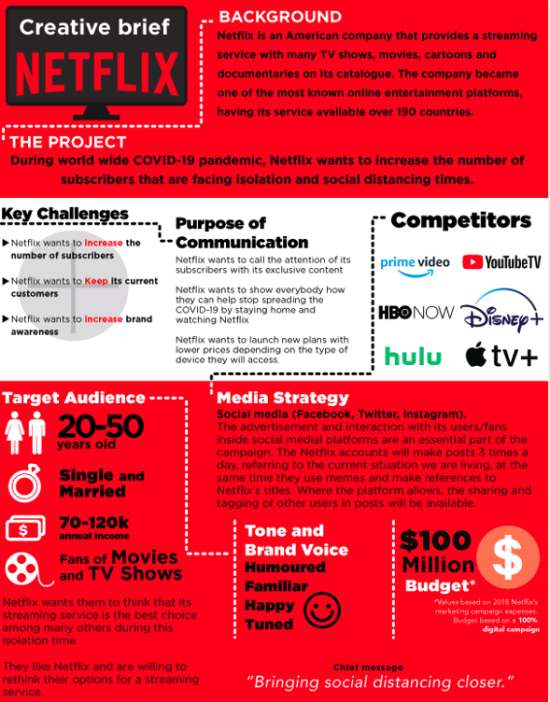
Nike Marketing Brief
In this brief, you can see that Nike has set out its objectives and who its target audience is. They’ve also communicated their problem and the big picture. This is interesting as the focus is on their employees instead of only shining the light on their products. It’s an exciting example if you want to develop a campaign that is not the norm.
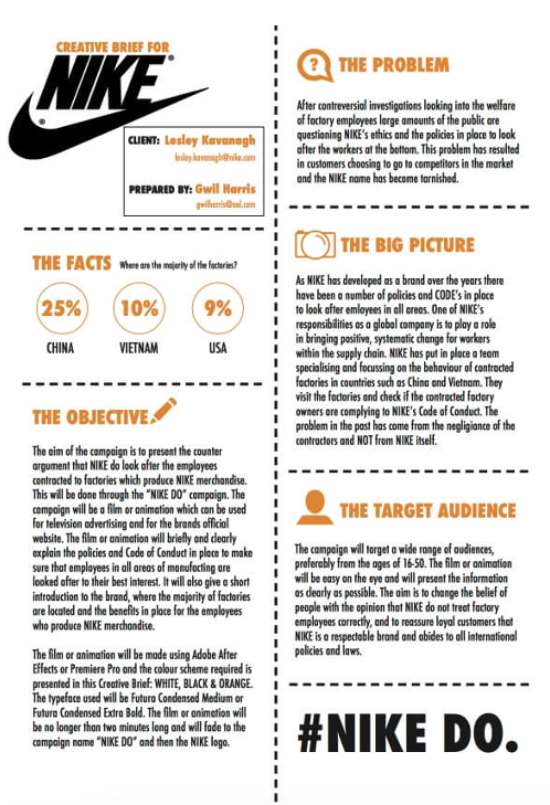 Paypal Marketing Brief
Paypal Marketing Brief
Paypal, an online payment platform, created this marketing brief to communicate that the company is more than just an alternative to credit card payments. They’ve set out their goal, provided key insights, and showcased who they will engage with. We like the inclusion of the main message, which makes what they want to communicate very clear.
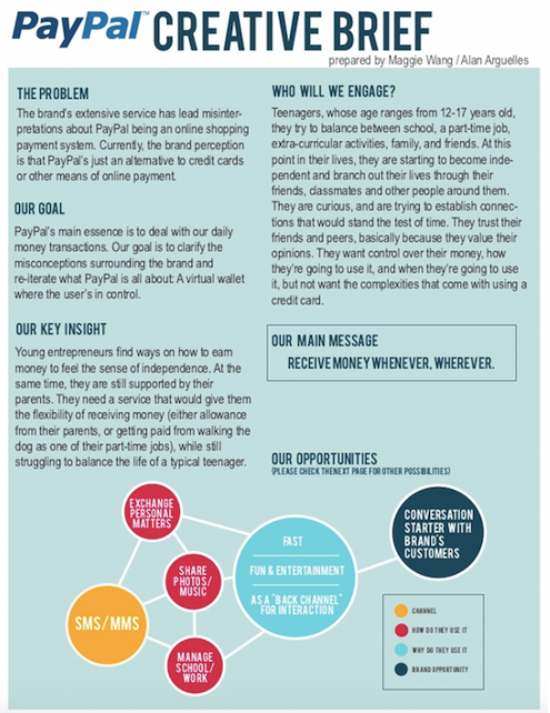
Example of Marketing Brief Created With AI
PureJuice Marketing Brief
Below is a great example of what you can do with the Media Shower Marketing Brief AI assistant. The marketing brief itself was generated using the assistant, and then the copy is passed along to a designer to create these types of eye-catching briefs to share with your team or clients.
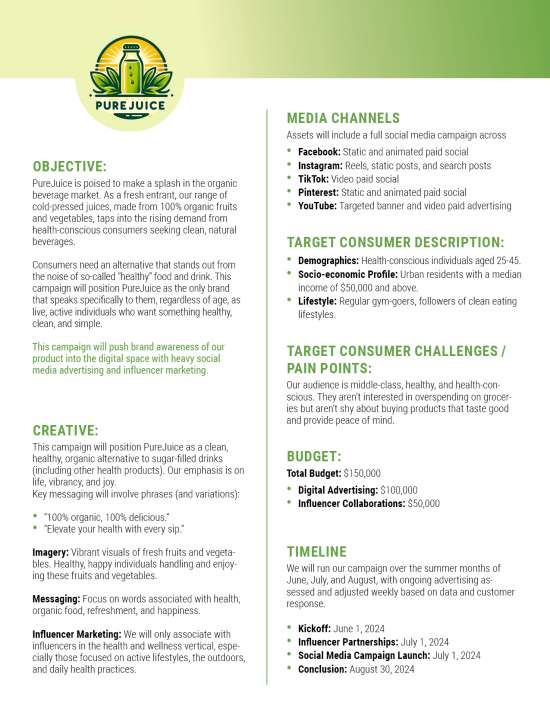 5 Best Practices When Developing a Marketing Brief
5 Best Practices When Developing a Marketing Brief
Here are five best practices to remember when creating a marketing brief for your business.
- Identify the Purpose of Your Campaign or Project: First, you need to understand exactly what you want to achieve. What goals are you working towards, what message are you communicating, etc? Adobe has a great guide to marketing campaign posts that you should read.
- Discuss the Project with Your Team First: Instead of creating a marketing brief alone, engage with your broader team to get their input on where the business would like to take the campaign. Choose people from various departments to get a broader perspective.
- Set Clear Goals: If you don’t set clear goals in your marketing brief, how can you expect the team to know where to go? These goals should be aligned with your broader company goals and objectives. Make sure that they are clear and concise.
- Understand Your Target Audience: As with our point above, how will the content team know what to create if you don’t know who you are targeting? Break your target audience down into specific demographics and understand their needs, wants, and pain points. If you don’t know who your target audience is, this digital marketing blog is a great place to start.
- List the Deliverables: Clearly set out the campaign’s deliverables. As with goals, this will enable your team to clearly understand what they need to deliver and what they need to work towards. Having deliverables in place will remove any ambiguity as to what is required.
Marketer’s Takeaway
Marketing briefs are critical to the success of marketing campaigns. A well-executed brief comprises campaign goals, information about target audiences, key messages, a budget breakdown, a detailed schedule, and metrics for evaluating campaign achievements.
Additionally, the brief provides a way to include people from different departments and perspectives to understand and contribute to your vision.
The Media Shower platform lets you draft great marketing briefs using our AI assistants, with an award-winning creative team to help you turn them into marketing magic. Click for a free trial.
